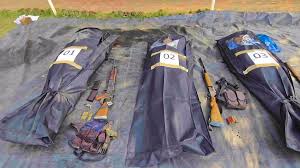Kothagudem: A high-intensity gunfire erupted around 8 AM on Saturday between security forces and Maoist insurgents in the dense forests along the Sukma-Bijapur border in Chhattisgarh. In the exchange of fire, 16 Maoists were killed, while search operations continue in the surrounding areas.
The joint operation, launched by the District Reserve Guard (DRG) and Central Reserve Police Force (CRPF) under the Kerlapal police station limits in Sukma on Friday, aimed to disrupt Maoist activities in the region. The rebels, often referred to as Naxalites, are part of the banned Communist Party of India (Maoist) and have waged an armed insurgency for decades, demanding land rights, better governance, and social justice for marginalized communities. However, their violent tactics, including attacks on security forces and civilians, have led to intensified counter-insurgency operations.
Watch Here: 16 Naxals Killed In Sukma Encounter
India To Be Naxal-Free By 2026: Amit Shah
During the encounter, security forces recovered a massive cache of weapons, including AK-47s, SLRs, INSAS rifles, .303 rifles, rocket launchers, BGL launchers, and explosives. Officials suspect that more Maoists might have been killed or injured, and patrolling efforts are still underway.
Also Read: 3 cops, 3 terrorists killed in J&K: Hunt was widened after 2 seen asking for water

This incident underscores the ongoing conflict in central India, where Maoists continue to operate in remote forested regions despite repeated crackdowns by security forces. The government has been pushing for a mix of military action and developmental initiatives to curb their influence.
Who Are the Naxalites?
The Naxalite movement traces its roots to the late 1960s in West Bengal’s Naxalbari village, where peasants revolted against landlords, demanding land reforms and justice. What began as a local uprising evolved into a full-fledged armed insurgency spanning multiple states, particularly in central and eastern India. Despite government efforts to integrate them into the mainstream through surrender policies and development programs, hardcore Maoist factions continue to resist, operating in remote, forested regions. The conflict remains one of India’s longest-running internal security challenges, affecting both civilians and security personnel.
